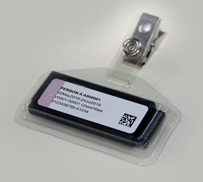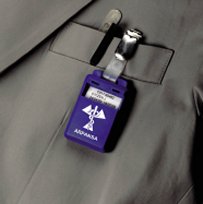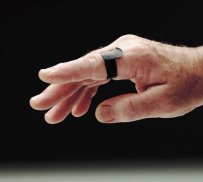Types of personal radiation monitors
The monitors in the list below can be used to measure workers' exposure to ionising radiation. Typically, the monitors would be worn by workers in the medical, dental, chiropractic, industrial and mining fields.
| Monitor name | Dosimeter type | Wearing position | X‑ray | Gamma ray | Fast neutrons |
|---|---|---|---|---|---|
| Full Body OSL | Optically stimulated luminescence | Chest / waist | Yes | Yes | No |
| Special TLD | Thermoluminescence | Chest / waist | Yes | Yes | No |
| Neutron / Photon | Poly-allyl-diglycol / Thermoluminescence | Chest / waist | Yes | Yes | Yes |
| Extremity | Thermoluminsescence | Finger | Yes | Yes | No |
Full body OSL monitor

What does it do?
A full body OSL monitor measures gamma and X-ray radiation exposure to the torso.
Where is it used?
It is typically used in the following industries:
- diagnostic radiology
- radiotherapy
- nuclear medicine
- dental
- chiropractic
- veterinary
- other industries where workers could be exposed to gamma and X-ray radiation.
How does it work?
It uses one control monitor per issue to measure the natural background where the monitors are stored.
Special TLD monitor

What does it do?
A special TDL monitor measures gamma and X-ray radiation exposure to the torso.
Where is it used?
It is used in the uranium and mineral sands mining industries.
How does it work?
It uses two control monitors per issue to measure the natural background and the background where the monitors are stored.
Neutron and photon monitor

What does it do?
A Neutorn and photon monitor measures gamma, X-ray and fast neutron radiation exposure to the torso.
Where is it used?
It is used by workers exposed to neutrons including workers using neutron generators or neutron probes.
How does it work?
It uses one control monitor per issue to measure the natural background where the monitors are stored.
Extremity monitor

What does it do?
An Extremity monitor measures gamma and X-ray radiation exposure to the extremities.
Where is it used?
It is used in the nuclear medicine industry and other industries where workers are handling radiation sources with their hands and are likely to receive a significant proportion of the dose limit (500,000 µSv) to the hands and feet.
How does it work?
It uses one control monitor per issue to measure the natural background where the monitors are stored. It is used in addition to other monitors that measure radiation exposure to the torso.
Personal radon monitor
What does it do?
A personal radon monitor measures radon in the air.
Where is it used?
It is used by workers exposed to radon in underground mines or caves.
How does it work?
It is worn on the torso for three months and returned for processing. The recommended action level for radon in the workplace is 1000 Becquerel per cubic metre.
Area radon monitor
What does it do?
An area radon monitor continuously measures radon in the environment.
Where is it used?
It is used by people concerned about radon in their homes.
How does it work?
It is placed in the bedroom or lounge room approximately 1 to 1.5 metres above the floor for between three to six months and returned for processing.


